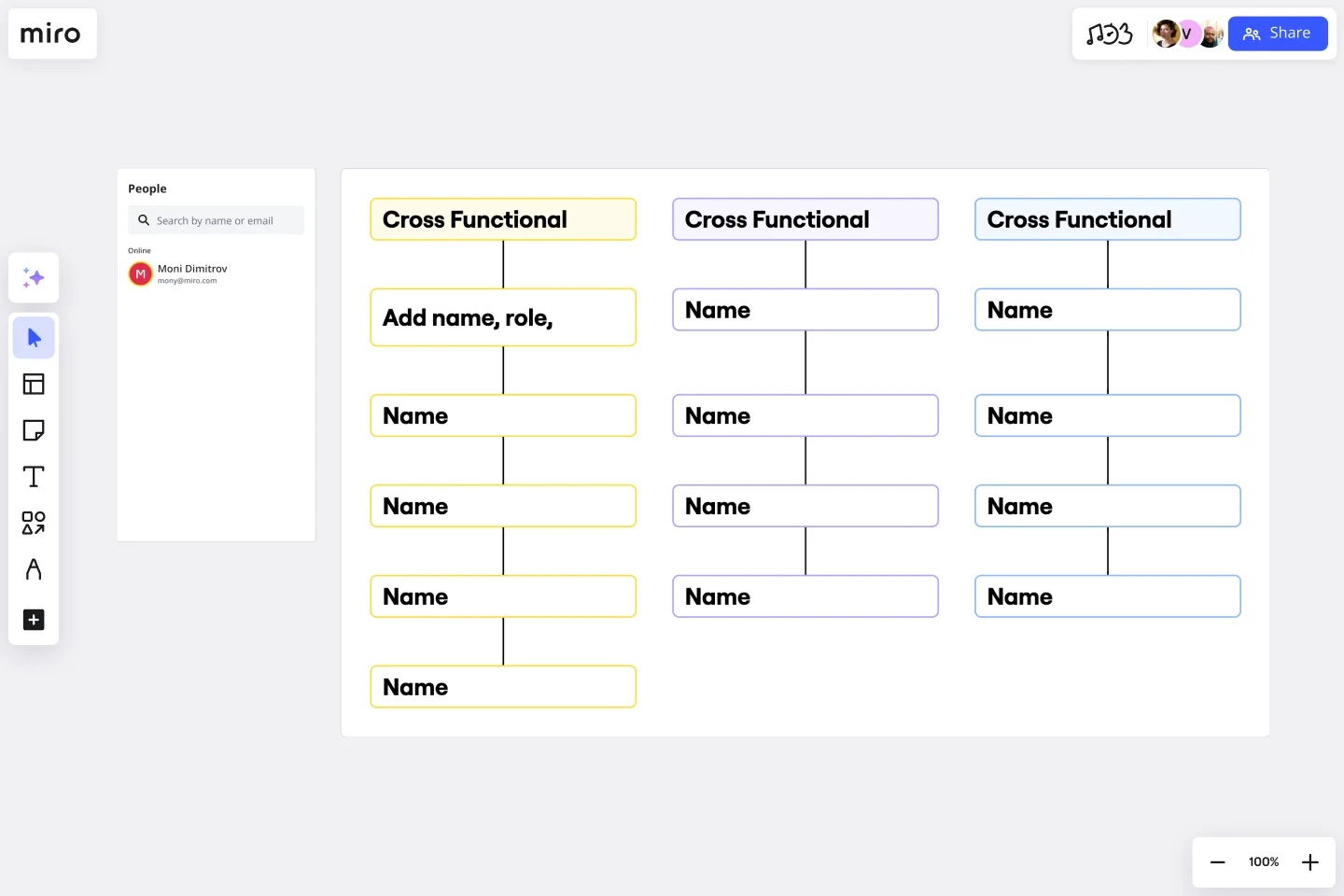Team (XFN) Chart Template
Illustrate the structure of three cross-functional teams within an organization with the team (XFN) chart template.
About the Team (XFN) Chart Template
The Team (XFN) Chart Template is a tool designed to enhance visibility and streamline the planning and execution processes within cross-functional teams. This template allows for a comprehensive view of team structures, responsibilities, and interdependencies, making it easier to identify each team member's roles and contributions. By using this template, teams can foster a more collaborative environment, ensuring that everyone is aligned with the project's goals and timelines.
How to use the team (XFN) chart template
Start with the basics: Outline your team's core structure. Use the template to map out your project's different roles and departments.
Define relationships and dependencies: Use the chart to illustrate the relationships between different team members and departments. Highlight any dependencies that might impact project execution, ensuring clarity on who relies on whom for information, resources, or decision-making.
Customize for clarity: The template is designed to be flexible. Add additional layers of information, such as project timelines, specific tasks, or key milestones, to provide a comprehensive overview of the project's scope and responsibilities.
Iterate and update: As projects evolve, so do team dynamics and requirements. Regularly revisit and update the team (XFN) chart to reflect any changes, ensuring that the chart remains a reliable source of truth for the entire team.
Why use a team (XFN) chart template
Maintaining clarity and alignment within cross-functional teams is more important than ever in today's fast-paced and interconnected work environments. The team (XFN) chart template serves as a foundational tool for achieving these objectives, offering several key benefits:
Enhanced visibility: The team (XFN) chart provides a bird's-eye view of the entire project team, making it easier to understand how different parts of the team fit together and contribute to the project's success.
Improved collaboration: By clearly defining roles, responsibilities, and dependencies, the chart encourages open communication and collaboration among team members, helping to break down silos and foster a more inclusive working environment.
Streamlined planning and execution: With a clear understanding of the team's structure and interdependencies, planning and execution become more efficient. Teams can anticipate potential bottlenecks or conflicts and address them proactively, leading to smoother project delivery.
Adaptability: The team (XFN) chart is adaptable to various project sizes and complexities. Whether you're working on a small initiative or a large-scale project, the chart can be customized to meet your team's specific needs.
Get started with this template right now.
Fantasy Heroes - Team Charter
Works best for:
Org Charts, Operations, Mapping
The Fantasy Heroes Team Charter template offers a creative approach to team chartering. By framing team roles and objectives within a fantasy theme, this template engages team members and encourages collaboration. With sections for defining team missions and superpowers, this template fosters a sense of purpose and camaraderie, enhancing team motivation and productivity.
Company Vision Board Template
Works best for:
Leadership, Org Charts
Find the path to innovation and growth with the Company Vision Board Template. Invite everyone to come together and decide on company direction and goals.
Accountability Chart Template
Works best for:
Organizational Chart, Org Design
The Accountability Chart Template is a visual map detailing the various roles within an organization and the responsibilities tied to each. This systematic layout ensures clarity in defining duties and fosters a culture of accountability. A standout benefit of using this template is its capacity to eliminate role ambiguity. The Accountability Chart template ensures that every team member understands tasks by clearly depicting who is responsible for what. This leads to enhanced productivity and reduced task overlaps or missed assignments.
Skill Gap Analysis Org Chart Template
Works best for:
Diagramming
The Skill Gap Analysis Org Chart Template helps organizations optimize their workforce by assessing and addressing skill gaps. It integrates skill analysis with succession planning, identifies leaders, and fosters cross-functional collaboration. This template aligns employee skills with organizational objectives for sustained success.
Chain of Command Template
Works best for:
Organizational design, Org chart
The Chain of Command Template represents an organization's hierarchical structure, paving the way for enhanced clarity in roles and responsibilities. One of its standout benefits is the promotion of efficient communication. By clearly delineating the channels of authority and the reporting structure, team members can effortlessly identify the right people to approach with specific queries, concerns, or updates. This streamlined communication fosters better team collaboration and ensures that pivotal information reaches its intended destination promptly, driving overall organizational efficiency.
Organizational Change Map
Works best for:
Org Charts, Operations, Mapping
The Organizational Change Map template helps teams navigate organizational change effectively. By visualizing change initiatives, stakeholders, and timelines, this template facilitates change planning and communication. With sections for documenting change impacts and mitigation strategies, this template empowers teams to manage change proactively and minimize disruption.
